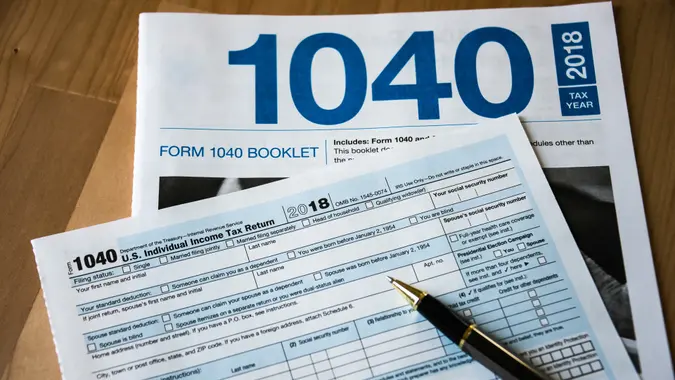Mileage Reimbursement Rate for 2025: What To Expect

Commitment to Our Readers
GOBankingRates' editorial team is committed to bringing you unbiased reviews and information. We use data-driven methodologies to evaluate financial products and services - our reviews and ratings are not influenced by advertisers. You can read more about our editorial guidelines and our products and services review methodology.

20 Years
Helping You Live Richer

Reviewed
by Experts

Trusted by
Millions of Readers
Driving can be more than just a part of your daily routine — it can also give you a deduction on your tax return. If you drive as part of your business, while volunteering for a charitable organization or for other eligible purposes, you might be able to deduct the cents per mile rate set by the IRS.
What Are IRS Mileage Reimbursement Rates?
The IRS mileage reimbursement rate is a deduction you can take for using a vehicle for qualifying purposes. This includes business, medical, moving or charitable purposes.
Sometimes called the “federal mileage rate,” the mileage reimbursement rate is based on the mileage used for that specific purpose. It’s meant to simplify how taxpayers — businesses and individuals — calculate their deductible mileage costs.
IRS Standard Mileage Rates for 2024
In December 2023, the IRS announced the standard mileage rates for 2024. While business rates have increased, other rates have either decreased or remained unchanged from the year before.
Here are the 2024 mileage reimbursement rates:
- Business mileage rate: 67 cents per mile. This mileage rate for business increased by 1.5 cent from 65.5 cents per mile in 2023.
- Military moving mileage rate: 21 cents per mile (1 cent decrease from 2023). Qualified active-duty Armed Forces members can deduct the miles they drive while moving, as long as the move stems from a military order for a permanent change of station.
- Medical and moving mileage rate: 21 cents per mile used for moving or medical purposes. Miles driven to receive medical care are eligible for the medical and dental expenses deduction at a rate of 22 cents per mile. You can deduct medical expenses that exceed 7.5% of your adjusted gross income if you itemize your deductions [3].
- Charitable mileage rate: 14 cents per mile driven while volunteering for a qualified charitable organization. Parking fees and tolls are also deductible. This rate is unchanged from 2023.
Note that prior to the 2017 Tax Cuts and Jobs Act, taxpayers could deduct miles as part of their deductions for non-military moving expenses and unreimbursed employee expenses. The TCJA eliminated those deductions until Jan. 1, 2026.
How IRS Mileage Reimbursement Rates Are Calculated
Each year, the Internal Revenue Service (IRS) sets the federal standard mileage reimbursement rate. This rate is for anyone — individuals or businesses — operating a vehicle for medical, moving, business or charitable purposes.
The actual per-mile reimbursement rate depends on the national average variable and fixed costs of operating a vehicle. The IRS uses an independent third-party contractor to assess these costs on an annual basis. The results determine the standard business rate and the medical and moving rate.
The way the charitable rate is determined is a little different. This rate is set by statute (Internal Revenue Code, §170(i)). Charitable contributions are tax deductible up to a certain amount for the year in which they’re made.
It’s important to note that fixed expenses — like insurance and vehicle depreciation — remain the same regardless of how far a vehicle travels. Variable expenses — like fuel, brakes and tires — do vary based on distance.
The business rate includes both fixed and variable costs, while the medical and moving rate only include variable costs. Standard mileage reimbursement rates don’t include parking or toll fees as these are a separate deduction.
What’s New In Federal Mileage Reimbursement Rates
The standard federal mileage reimbursement rate has changed over the years. Here’s how the rates have changed for business purposes:
- 2024 — 67 cents per mile
- 2023 — 65.5 cents per mile
- Second half of 2022 — 62.5 cents per mile
- First half of 2022 — 58.5 cents per mile
- 2021 — 56 cents per mile
- 2020 — 57.5 cents per mile
- 2019 — 58 cents per mile
- 2018 — 54.5 cents per mile
- 2017 — 53.5 cents per mile
- 2016 — 54 cents per mile
- 2015 — 57.5 cents per mile
- 2014 — 56 cents per mile
- 2013 — 56.5 cents per mile
- 2012 — 55.5 cents per mile
- Second half of 2011 — 55.5 cents per mile
- First half of 2011 — 51 cents per mile
And here’s how the rates have changed for medical or military moving:
- 2024 — 21 cents per mile
- 2023 — 22 cents per mile
- Second half of 2022 — 22 cents per mile
- First half of 2022 — 18 cents per mile
- 2021 — 16 cents per mile
- 2020 — 17 cents per mile
- 2019 — 20 cents per mile
- 2018 — 18 cents per mile
- 2017 — 17 cents per mile
- 2016 — 19 cents per mile
- 2015 — 23 cents per mile
- 2014 — 23.5 cents per mile
- 2013 — 24 cents per mile
- 2012 — 23 cents per mile
- Second half of 2011 — 23.5 cents per mile
- First half of 2011 — 19 cents per mile
The mileage rate for charity purposes has remained unchanged at 14 cents per mile from 2011 to 2024.
Standard Mileage Rate vs. Actual Expense Method
Not everything is tax deductible. For example, you may be able to claim a reimbursement for business-related trips, but not for your daily commute to and from work.
When deciding how to deduct mileage from your taxes, you have two options: the standard mileage rate and the actual expense method. Note that you can only choose one of these.
Standard Mileage Rate
The standard mileage rate is the most straightforward method to determine your mileage. To calculate mileage reimbursement, you’ll need to multiply the current IRS mileage by the number of business-related miles you’ve driven.
Certain rules apply. For example, you must either lease or own the vehicle used to drive for business purposes. Learn more about the IRS’s rules for business-related car usage. If you’re an active-duty service member, you can also deduct mileage for moving expenses. This generally only applies to a permanent move needed to change stations. However, some states allow nonmilitary personnel to deduct moving expenses as well.
You may also be able to take the mileage rate deduction for qualifying medical reasons — like doctor’s visits for yourself, a child or another person. As a rule of thumb, you can only deduct medical expenses greater than 7.5% of your adjusted gross income.
Actual Expense Rate
Actual expenses are the actual costs of operating your vehicle for any of the purposes allowed by the IRS: business, a military move, medical expenses or volunteering. These expenses would include the cost of gas and oil in place of the mileage rate, plus parking fees and tolls, which the IRS says are separately deductible whether your use the standard mileage rate or actual expenses.
Other qualifying expenses include vehicle depreciation, the cost of licensing, lease payments, and repairs or maintenance.
How to Track Mileage for IRS Reimbursement
If you plan to deduct mileage when filing taxes, you must itemize on your tax return. You can do this in one of the following ways:
- Complete Form 1040 and Schedule A
- Claim the deduction as a business expense on Schedule C (if self-employed)
- Input information about your mileage using a tax software
Tracking your mileage is crucial since the IRS could audit you. If you don’t have the proof to back up your claimed deduction, you could end up in financial — and possibly legal — trouble.
The good news is that you can calculate your mileage reimbursement using a tool or app. Many mileage tracking apps can help you easily account for miles and expenses you have incurred throughout the tax year. Here are some highly recommended tracking apps to consider:
- Everlance
- Rydoo
- Zoho Expense
- Shoeboxed
You can also keep track of your mileage manually by logging miles in a notebook or notes app on your phone. You could even use pen and paper. Keep detailed notes of the total mileage per trip, the trip purpose, your destination and the total mileage that year.
How To Calculate Mileage Costs
In order to get the most bang for your buck, it is important to know how to calculate your mileage costs. Here is the breakdown for the two most common ways to use the standard mileage rate: business tax deductions and employee mileage reimbursements.
Business/Self-Employed Tax Deductions
When it comes time to file your taxes, here is how you would calculate your miles.
- Total up your miles. For this example, your total is 500 business miles.
- Multiple that number by the $0.655 standard mileage rate for business.
- 500 business miles multiplied by $0.655 is $327.50
- Your deduction would be $327.50.
You can use this method of calculation for military move, medical expense and charity miles, too — just swap out the business mileage rate for the applicable rate.
Employee Mileage Reimbursements
Although you can’t deduct unreimbursed employee miles on your tax return, your employer might reimburse you for each mile you drive for your job.
If it does, calculate the reimbursement in the same way you calculate the tax deduction — multiply the number of miles you drove by your employer’s mileage reimbursement rate, which may or may not differ from the IRS rate for business miles. If, for example, you drove 100 miles and your employer reimburses you at 65.5 cents per mile, multiply 0.655 by 100. Your reimbursement would be $65.50.
Regardless of whether you’re an employee, employer or self-employed, you can also use a mileage calculator to calculate your mileage reimbursement.
Strategies to Maximize Business Deductions
Understanding the IRS reimbursable mileage rate is one way to maximize business tax deductions, but here are a few other methods:
- Claim business credits: This may include the employer-provided childcare credit, clean vehicle credit, work opportunity tax credit or the FICA tip credit.
- Make charitable donations: Businesses may deduct charitable contributions from their taxable income — up to 25%. The contribution must be paid in cash to a qualifying organization. The deduction must be made during the current tax year.
- Consult a tax professional: A tax professional should know the current tax legislation inside and out. Speak with one about your options and which deductions, tax exemptions and credits might be available to you.
Common Mistakes to Avoid
The rules surrounding the IRS mileage reimbursement rate can be tricky, but it’s still important to get the calculations right. Throughout the year, you should be tracking all mileage for yourself, your business and any employees. Without proper documentation, you might not get reimbursed.
You may also want to use an automatic tracking system, like an app on your phone. While you can track the mileage manually, you’re more likely to make mistakes or miss something that winds up being crucial during tax time.
If you do choose a tracking tool, make sure it’s one that suits your needs. Otherwise, you may be less likely to use it as consistently as you should. This can also lead to missed mileage for reimbursement purposes, or future costly errors.
Remember that some things are not reimbursable. Keep current on what the current IRS mileage reimbursement rate is, what it does and does not cover and any recent changes for the year. When in doubt, use a mileage calculator to cross reference the numbers and ensure you’re getting the most out of your deductions.
How to Claim IRS Mileage Reimbursement on Your Taxes
When it comes time to file taxes, here’s how to claim the IRS mileage reimbursement:
- Determine a mileage reimbursement method: You can use either the standard or the actual expenses method. Be sure to keep detailed records of every eligible trip and any related fixed or variable costs (as applies to your situation).
- Get your documents together: Gather any records related to your qualifying mileage usage. This could be for business purposes, military-related moves or medical or charitable expenses.
- Calculate your mileage reimbursement: Do this using a mileage calculator, tax software or with the aid of a tax professional.
- Complete the appropriate tax forms: Self-employed individuals or business owners must fill out Schedule C, Part II, Line 9. Employees will need to complete Form 2106.
- Check into state reimbursement options: Some states have their own tax regulations. See if you qualify for any additional deductions before filing.
- Keep ongoing records: Even after filing taxes, keep those records. That way, you’ll have them in case there’s ever an audit.
Final Take: Manage Your Mileage
The cost of all the miles you put in for your business, volunteer work, medical care and volunteering doesn’t have to come entirely out of your pocket. Just don’t wait until the end of the tax year to try and figure out how many miles you have driven for these deductible activities. The IRS requires that you maintain written evidence of the mileage you claim.
You can do that by keeping a daily log in a notebook or notes app in your phone. But the easiest way might be to download an app to your phone that tracks the mileage for you. Everlance, Stride and Driversnote are just a few of the highly rated apps available that take the hassle out of keeping track of your miles. In a pinch, you can always snap a photo of your odometer before and after your travels.
FAQ
- Can you deduct mileage for commuting to work?
- You cannot take deductions for your daily commute. However, you can claim mileage reimbursement for miles directly related to your business. This may include business trips, client meetings or other work-related tasks.
- Are there mileage deductions for electric or hybrid vehicles?
- The standard mileage rate is 67 cents per mile for business purposes, 21 cents per mile for medical or moving purposes and 14 cents per mile for charitable purposes. These rates apply to gas-powered, diesel, hybrid and electric vehicles.
- What happens if you don't keep accurate mileage records?
- If you don't keep accurate records throughout the year, you could miss out on important tax deductions. Improper documentation could also result in an IRS audit. Failing the audit could mean a higher tax bill or additional penalties.
- What's the IRS 2025 Mileage Reimbursement Rate?
- The IRS publishes the mileage reimbursement rate once a year. Currently, the latest available mileage reimbursement rate is for 2024. Check the IRS's website around the end of the year (December) to find out the coming year's reimbursement rate.
Caitlyn Moorhead and Daria Uhlig contributed to the reporting for this article.
Our in-house research team and on-site financial experts work together to create content that’s accurate, impartial, and up to date. We fact-check every single statistic, quote and fact using trusted primary resources to make sure the information we provide is correct. You can learn more about GOBankingRates’ processes and standards in our editorial policy.
 Written by
Written by  Edited by
Edited by 

























